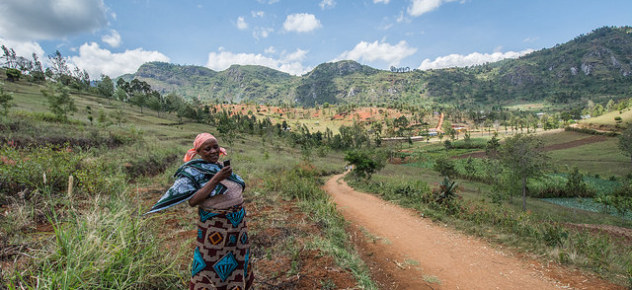
Restoring degraded land has many potential benefits, including more carbon sequestration, reduced deforestation, increased agricultural productivity, and better rural livelihoods. Credit: Georgina Smith / CIAT
After years of neglect, large-scale restoration of degraded land is winning major support from governments and even private investors. The potential benefits – such as more carbon sequestration, reduced deforestation, increased agricultural productivity, and better rural livelihoods – are large. But so are the pitfalls. Can we be sure that the technologies available today will restore land successfully? How can we know whether the benefits will be shared equitably, meeting the expectations of committed governments and financial investors, while also satisfying the aspirations of rural people?
To reduce Latin America’s carbon footprint, restore degraded land http://t.co/mojG5IkDI9 @WorldResources #COP20 pic.twitter.com/bcVYt0hjaB
— RRI (@RightsResources) December 9, 2014
To help find answers to these questions, CIAT joined several partner organizations this year in supporting a new country-led effort called Initiative 20×20. Aiming to have 20 million hectares of degraded land in Latin America and the Caribbean (LAC) on the road to restoration by 2020, the Initiative supports the Bonn Challenge, which seeks to restore 150 million hectares of land globally by 2020.
Initiative 20×20 was launched with considerable fanfare and media coverage at the Global Landscapes Forum (GLF 2014), held last December in Lima, Peru, alongside the United Nations Conference on Climate Change. Present at the launch, organized by Walter Vergara of the World Resources Institute (WRI), were agricultural and environment ministers from a half dozen countries that have already made commitments to restore sizeable areas – 8.5 million hectares in Mexico, for example, and 1 million in Colombia.
WRI great initiative project 20 by 20 intends to restore 20 million ha of degraded land in Latin America & Caribbean in restoration by 2020 — Green Belt Movement (@GreenBeltMovmnt) December 10, 2014
The event was also attended by representatives from five private investment funds, with plans to channel up to US$365 million of new financing into the region’s land restoration efforts. The Initiative is supported by WRI, CIAT, the Tropical Agricultural Research and Higher Education Center (CATIE), and International Union for the Conservation of Nature (IUCN). In early 2015, these organizations moved quickly to define next steps (for example, through planning meetings held in Colombia) and put in place the Initiative’s technical underpinnings.
“CIAT is committed to supporting Initiative 20×20, because large-scale land restoration is critical for realizing this region’s potential as a global food basket and provider of ecosystem services, like biodiversity and climate change mitigation,” said Ruben Echeverría, CIAT’s director general.
To explore the challenges of large-scale land restoration from diverse perspectives, CIAT and the CGIAR Program on Water, Land and Ecosystems (WLE) jointly organized a GLF 2014 discussion forum titled “Creating the conditions for success,” which immediately followed the 20×20 launch. Much of the discussion centered on the value of knowledge for creating trust among the various groups who have a stake in landscape restoration.
“For private investors,” said Leslie Durschinger, founder and managing director of Terra Global Capital, “we must generate enough knowledge to demonstrate that investing in land restoration is commercially viable.”
Despite controversy surrounding private investment in land restoration, there is growing recognition that without it, sustainable solutions to land degradation will remain elusive, especially given the huge scope of the problem. In LAC, as much as 200 million hectares of land are already degraded, according to WRI and IUCN estimates. Continuing changes in land-use account for about two-thirds of the region’s greenhouse gas emissions, in addition to causing the loss of biodiversity and productive capacity.
“Degraded landscapes in the region are highly diverse, encompassing crop land and pastures as well as forests under varying degrees of pressure,” said Elcio Guimarães, CIAT’s regional director for LAC. “Consequently, each national effort to restore these landscapes requires a unique combination of policy, financial, and science components to ensure success.”
“Science can help boost the odds that investments will meet their objectives,” said Deborah Bossio, director of CIAT’s Soils Research Area. For this purpose, Center scientists apply new modeling tools and participatory approaches to evaluate investment options and determine which are most likely to increase agricultural productivity, enhance rural livelihoods, and restore ecosystem services.
Renewed interest in landscape restoration is evident in Africa as well, and for this reason the CIAT-WLE forum included representatives from the environmental ministries of Ethiopia and Malawi. They echoed the concerns of other participants about perceived gaps in trust, particularly between government- and NGO-driven programs and rural communities.
“We need to build trust by integrating scientific expertise but also indigenous knowledge into landscape restoration,” said Aloysius Kamperewera, director of environmental affairs with Malawi’s Ministry of Natural Resources, Energy, and Environment.
“Building trust and confidence,” explained Bossio, “is all about accountability and transparency. Large-scale land-restoration efforts need to have built-in accountability mechanisms that draw on science-based evidence.”